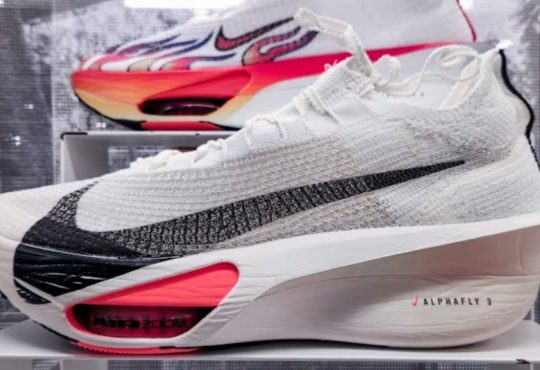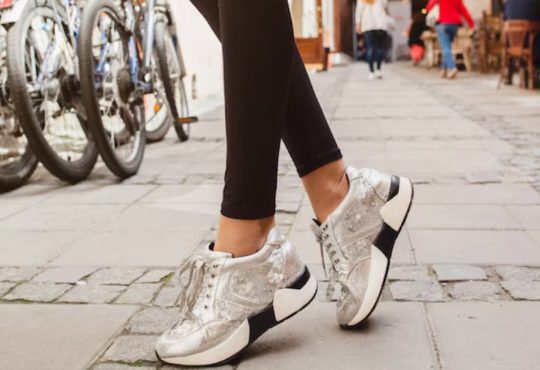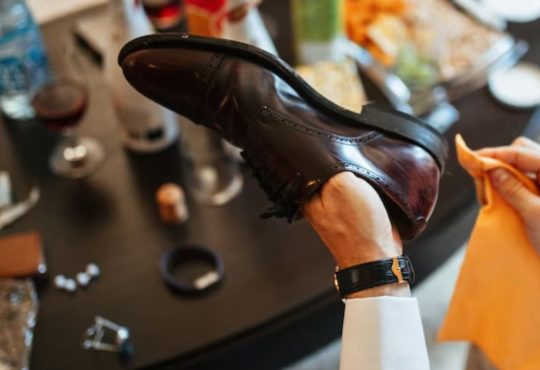Leather soles are celebrated for their sophistication, durability, and timeless appeal, offering both luxury and comfort for those who appreciate fine craftsmanship in footwear. However, proper shoe care is essential to maintaining their exceptional quality. Unlike rubber soles, which offer more resistance to wear and environmental elements, leather soles demand more attention to preserve their structure, function, and visual charm. This in-depth shoe care guide will help you protect and prolong the life of your leather soles.
Top 15 Shoe Care Tips: How to Maintain Leather Soles
1. Regular Cleaning and Drying
Leather soles are naturally absorbent, so it’s essential to keep them clean and dry to prevent degradation. After each wear, particularly on wet or muddy surfaces, wipe off any dirt or moisture using a soft cloth. Allow the shoes to air dry at room temperature, keeping them away from direct sunlight or heat sources such as radiators, which can lead to the leather becoming dry and prone to cracking.
2. Rotating Shoes
To prevent excessive wear on a single pair, it’s best to rotate your shoes regularly. Wearing the same pair every day can lead to faster degradation of the leather sole, as the material doesn’t have time to recover. By alternating between multiple pairs, each pair gets the chance to dry out and retain its shape. This helps to avoid creating uneven wear patterns, allowing your shoes to last much longer.
3. Using Shoe Trees
One of the most effective tools for maintaining the shape and condition of leather-soled shoes is a cedar shoe tree. These inserts not only help keep the shoes in their intended shape by preventing the leather from creasing, but they also absorb moisture that builds up from the foot. Cedar, in particular, is excellent for absorbing sweat and preventing odors, thus preserving both the form and longevity of your shoes.
4. Protecting the Soles from Water and Wet Conditions
Leather soles can be vulnerable to water damage, which can cause them to weaken or lose their shape over time. Whenever possible, avoid wearing leather-soled shoes in the rain or on wet surfaces. If you do get caught in wet conditions, try to dry the soles as soon as possible by gently blotting them with a cloth and then allowing them to air-dry.
If protecting your leather soles from moisture is a constant concern, consider applying a protective water-repellent spray. These sprays form an invisible barrier over the leather, helping to shield it from water and grime. Be sure to test the spray on a small, inconspicuous area of the shoe before full application to ensure it doesn’t affect the color or texture.
5. Sole Maintenance and Resoling
The lifespan of leather soles can be extended significantly through regular maintenance, especially when the soles begin to show signs of wear. An experienced cobbler can replace the worn leather soles with fresh ones, giving your shoes a new lease of life. This is particularly important if the leather sole is part of a quality shoe that can be reconditioned rather than discarded.
Leather-soled shoes constructed with Goodyear welting, Blake stitching, or hand-welting offer the most repairability, as they are designed to have their soles replaced without compromising the integrity of the upper part of the shoe. Regularly inspecting the soles for signs of wear, such as thinning or visible cracks, can help you determine when it’s time for resoling.
6. Buffing and Polishing
Buffing and polishing leather soles not only enhances their shine but also helps preserve the leather by applying a thin layer of wax or cream that can protect against moisture and dirt buildup. Use a soft brush or cloth to apply a shoe polish made specifically for leather. For the best results, select a neutral polish or one that matches the color of your shoe.
When buffing, focus on the edges of the soles and the welt stitching, as these areas are particularly susceptible to wear. Regular polishing can also prevent the soles from becoming overly dry, which may result in cracking and splitting over time.
7. Adding Rubber Sole Protectors
Although leather soles are known for their elegant appearance, they can be slippery, especially on wet or uneven surfaces. One way to improve traction without compromising the aesthetic appeal of leather soles is to add a thin rubber sole protector. These protectors are typically applied to the front half of the sole, providing extra grip while preserving the look of the leather.
Cobblers often fit rubber sole protectors, and they can be a wise investment for those who wear leather-soled shoes in harsh conditions or on slick surfaces. These inserts are particularly useful for adding durability to leather soles without sacrificing style or comfort.
8. Storing Leather-Soled Shoes
When not in use, proper storage is key to maintaining the quality of leather-soled shoes. Store shoes in a cool, dry place away from direct sunlight to prevent fading, cracking, or warping. Keep the shoes in a breathable dust bag or on a shelf where they won’t be squished or bent. If storing shoes for an extended period, it’s advisable to insert shoe trees and, if necessary, use shoe covers to protect them from dust and debris.
9. Avoiding Harsh Conditions
Leather-soled shoes are ideal for dry, temperate environments but are not suited for rugged or extreme conditions. For example, wearing leather soles on rocky terrain, wet streets, or icy conditions can lead to premature wear and potential damage. In situations where harsh conditions are unavoidable, consider using shoes with rubber or composite soles or invest in waterproof leather options designed for outdoor use.
10. Understanding Wear Patterns and Early Intervention
A key method to extend the lifespan of leather soles is by paying attention to how they degrade over time. Over time, leather naturally develops patterns of use that can lead to uneven wear if not addressed. For example, the heel and the ball of the foot are typically the most stressed areas and may show signs of thinning or even cracking if the shoes aren’t rotated often enough.
Paying attention to early signs of wear can help you address issues before they become more serious. If you observe that one side of the sole is wearing down more quickly than the other, it could suggest an imbalance in your walk or stance. Seeking guidance from a shoemaker on how to address the uneven wear can help avert additional harm. Early intervention can often save you from needing an entire resoling and can give your shoes a longer lifespan.
11. Shoe Maintenance During Seasonal Changes
Changing seasons can have a significant impact on leather soles. Cold, wet winters or hot, dry summers can affect the leather in different ways. Winter moisture and salt can make the leather stiff, cause it to crack, or lead to discoloration, while the summer heat can dry out the leather, resulting in cracks and brittleness.
During the colder months, it’s important to clean your leather soles after each wear to remove salt or grime buildup, which can deteriorate the leather over time. A damp cloth, followed by drying the shoes at room temperature, will help preserve the material. In warmer months, leather soles can become dry and prone to cracking. Applying a conditioner or cream made specifically for leather helps keep the soles supple and resistant to environmental damage.
12. Using Leather Conditioner and Protectant
Leather conditioner plays a key role in preventing your soles from drying out and cracking. Leather gradually loses its natural oils over time, particularly when exposed to air and environmental factors. Using a good leather conditioner helps replenish these oils and keeps the material soft, flexible, and less prone to damage.
When applying conditioner, be sure to use a product that is specifically formulated for footwear and doesn’t contain harsh chemicals or silicones, which can damage the leather over time. Conditioner should be applied in moderation to avoid leaving a greasy or overly shiny finish. Applying a protectant spray after conditioning can offer an additional layer of defense against moisture, dirt, and stains, providing further protection for your leather soles.
13. Preventing the Shoes from Losing Their Shape
Leather shoes, especially those with leather soles, are susceptible to losing their shape over time, particularly in the toe box and heel areas. Maintaining the shoe’s original structure is key to preserving both its aesthetic appeal and comfort.
Using a quality shoe tree is the best way to maintain the shape of leather-soled shoes when they are not in use. Cedar shoe trees are highly effective as they not only support the shoe’s structure but also absorb moisture, which can otherwise cause the leather to warp or degrade. When purchasing shoe trees, make sure they are the correct size for your shoes—too small, and they won’t provide adequate support; too large, and they may stretch the leather.
14. Caring for the Welt
The welt is an important part of the construction of leather-soled shoes, particularly those made with the Goodyear welt or Blake stitch methods. This small strip of leather or fabric connects the upper part of the shoe to the sole, playing a key role in the shoe’s overall structure and durability.
To maintain the welt and ensure your shoes remain water-resistant and durable, it’s important to keep them clean and free of debris. The welt area is also a place where moisture can collect, so regularly wiping it down and applying a waterproofing treatment to both the welt and the leather sole can help extend the life of your shoes. In cases where the welt starts to become loose or damaged, it’s best to consult a cobbler who can repair or replace it, ensuring the overall integrity of the shoe remains intact.
15. Choosing the Right Insoles
In addition to caring for the leather soles, it’s also important to pay attention to the insoles of your leather-soled shoes. Insoles, especially in high-end shoes, can significantly affect both the comfort and durability of the shoe. Insoles that provide additional cushioning can help absorb shock, reduce pressure on the soles, and prevent undue strain on the leather.
Choosing high-quality insoles made from materials like memory foam or gel can also protect the sole from rapid wear. Moreover, these insoles can reduce the friction between your foot and the shoe, preventing unnecessary damage to both the leather sole and the interior of the shoe.
Longevity Through Leather Care
Caring for leather soles requires a blend of regular maintenance, careful storage, and proactive protection. With the right approach, it’s possible to keep your leather-soled shoes looking and performing at their best for many years. Whether it’s keeping the boots dry, using cedar shoe trees, or applying conditioners to nourish the leather, each of these practices contributes to ensuring the longevity and durability of the soles.
By investing time in proper care and attention, leather-soled footwear remains a worthy investment. Not only does it offer unmatched elegance, comfort, and durability, but it also represents an appreciation for traditional craftsmanship and a timeless style. Proper shoe care ensures that the fine craftsmanship of leather soles continues to shine through, providing value for years to come.





